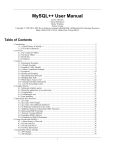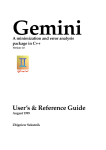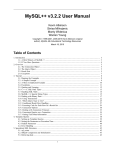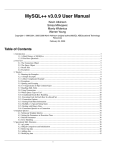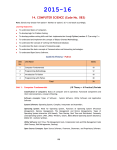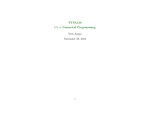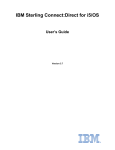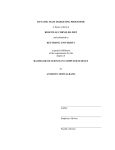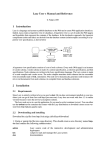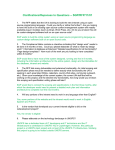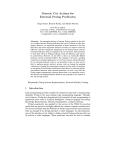Download MySQL++ User Manual
Transcript
MySQL++ User Manual
Kevin Atkinson
Sinisa Milivojevic
Monty Widenius
Warren Young
Copyright © 1998-2001, 2005 Kevin AtkinsonMySQL ABEducational Technology Resources
$Date: 2005-05-26 07:28:32 -0600 (Thu, 26 May 2005) $
Table of Contents
1. Introduction ............................................................................................................................ 2
1.1. A Brief History of MySQL++ .......................................................................................... 2
1.2. If You Have Questions... ................................................................................................. 2
2. Overview ............................................................................................................................... 3
2.1. The Connection Object ................................................................................................... 3
2.2. The Query Object .......................................................................................................... 3
2.3. Result Sets ................................................................................................................... 3
2.4. Exceptions ................................................................................................................... 4
3. Tutorial .................................................................................................................................. 5
3.1. Running the Examples ................................................................................................... 5
3.2. The Basics ................................................................................................................... 5
3.3. Quoting and Escaping .................................................................................................. 10
3.4. Specialized SQL Structures ........................................................................................... 11
3.5. Handling SQL Nulls .................................................................................................... 16
3.6. Which Query Type to Use? ........................................................................................... 17
3.7. Let's Do Something Useful ............................................................................................ 17
4. Template Queries ................................................................................................................... 21
4.1. Setting up template queries ........................................................................................... 22
4.2. Setting the parameters at execution time .......................................................................... 23
4.3. Using defaults ............................................................................................................ 23
4.4. Combining the two ...................................................................................................... 24
4.5. Error Handling ............................................................................................................ 24
5. Specialized SQL Structures ..................................................................................................... 26
5.1. sql_create .................................................................................................................. 26
5.2. sql_create with Compare ............................................................................................... 26
5.3. sql_create with Additional Initializers ............................................................................. 27
5.4. Additional Features of Specialized SQL Structures ............................................................ 28
5.5. Harnessing SSQLS Internals .......................................................................................... 28
5.6. Alternate Creation Methods ........................................................................................... 31
5.7. Expanding SSQLS Macros ............................................................................................ 31
5.8. Extending the SSQLS Mechanism .................................................................................. 31
6. Using Unicode with MySQL++ ................................................................................................ 33
6.1. A Short History of Unicode ........................................................................................... 33
6.2. Unicode and Unix ....................................................................................................... 33
6.3. Unicode and Win32 ..................................................................................................... 33
6.4. For More Information .................................................................................................. 34
7. Licensing ............................................................................................................................. 35
7.1. GNU Lesser General Public License ............................................................................... 35
1
MySQL++ User Manual
1. Introduction
MySQL++ is a powerful C++ wrapper for MySQL's C API. Its purpose is to make working with queries as easy as
working with STL containers.
The latest version of MySQL++ can be found at the official web site.
Support for MySQL++ can be had on the mailing list. That page hosts the mailing list archives, and tells you how
you can subscribe.
1.1. A Brief History of MySQL++
MySQL++ was created in 1998 by Kevin Atkinson. It started out MySQL-specific, but there were early efforts to try
and make it database-independent, and call it SQL++. This is where the old library name "sqlplus" came from. This
is also why the old versions prefixed some class names with "Mysql" but not others: the others were supposed to be
the database-independent parts.
Then in 1999, Sinisa Milivojevic unofficially took over maintenance of the library, releasing versions 1.0 and 1.1.
(All of Kevin's releases were pre-1.0 point releases.) Kevin gave over maintenance to Sinisa officially with 1.2, and
Sinisa went on to maintain the library through 1.7.9, released in mid-2001. Since Sinisa is an employee of MySQL
AB, it seems to be during this time that the dream of multiple-database compatibility died.
With version 1.7.9, MySQL++ went into a period of stasis, lasting over three years. During this time, Sinisa ran the
MySQL++ mailing list and supported its users, but made no new releases. There were many patches submitted during this period, some of which were ignored, others which were just put on the MySQL++ web site for people to try.
A lot of these patches were mutually-incompatible, and not all of them gave a fully-functional copy of MySQL++.
Most of them centered on GCC compatibility, because GCC 3 was created around this same time. The continual
tightening of the rules starting with GCC 3.0 exposed a lot of places in MySQL++ that used deprecated and nonconforming facilities.
In early August of 2004, the current maintainer (Warren Young) got fed up with this situation and took over. He released 1.7.10 later that month.
1.2. If You Have Questions...
If you want to email someone to ask questions about this library, we greatly prefer that you send mail to the
MySQL++ mailing list. The mailing list is archived, so if you have questions, do a search to see if the question has
been asked before.
You may find people's individual email addresses in various files within the MySQL++ distribution. Please do not
send mail to them unless you are sending something that is inherently personal. Questions that are about MySQL++
usage may well be ignored if you send them to our personal email accounts. Those of us still active in MySQL++
development monitor the mailing list, so you aren't getting any extra "coverage" by sending messages to those addresses in addition to the mailing list.
2
MySQL++ User Manual
2. Overview
MySQL++ has developed into a very complex and powerful library, with many different ways to accomplish the
same task. Unfortunately, this means that figuring out how to perform a simple task can be frustrating for new users.
In this section we will provide an overview of the most important user-facing components of the library.
The overall process for using MySQL++ is similar to that of most other database access APIs:
1.
Open the connection
2.
Form and execute the query
3.
Iterate through the result set
4.
Go to 2 :)
There is, however, a lot of extra functionality along each step of the way.
2.1. The Connection Object
A Connection object manages the connection to the MySQL server. You need at least one of these objects to do anything. A Connection object can either create Query objects for you, or you can execute queries directly through the
Connection object. The separate Query object is the recommended way as it gives you far more power.
2.2. The Query Object
A Query object is the recommended way of building and executing queries. It is subclassed from
std::stringstream which means you can write to it like any other C++ stream to form a query. The library includes stream manipulators that make it easy to generate syntactically-correct SQL.
You can also set up template queries with this class. Template queries work something like the C printf() function: you set up a fixed query string with tags inside that indicate where to insert the variable parts. If you have multiple queries that are structurally similar, you simply set up one template query, and use that in the various locations
of your program.
A third method for building queries is to use Specialized SQL Structures (SSQLS). This feature presents your results
as a C++ data structure, instead of making you access the data through MySQL++ intermediary classes. It also reduces the amount of embedded SQL code your program needs.
2.3. Result Sets
The field data in a result set are stored in a special std::string-like class called ColData. This class has conversion operators that let you automatically convert these objects to any of the basic C data types. Additionally,
MySQL++ defines classes like DateTime, which you can initialize from a MySQL DATETIME string. These automatic conversions are protected against bad conversions, and can either set a warning flag or throw an exception, depending on how you set the library up.
As for the result sets as a whole, MySQL++ has a number of different ways of representing them:
Queries That Do Not Return Data
Not all SQL queries return data. An example is CREATE TABLE. For these types of queries, there is a special result
type that simply reports the state resulting from the query: whether the query was successful, how many rows it impacted (if any), etc.
3
MySQL++ User Manual
Queries That Return Data: Dynamic Method
The easiest way to retrieve data from MySQL uses a Result object, which includes one or more Row objects. Because these classes are std::vector-like containers, you can treat the result set as a two-dimensional array. For
example, you can get the 5th item on the 2nd row by simply saying result[1][4]. You can also access row elements by field name, like this: result[2].lookup_by_name("price").
An alternate way of accessing your query results is through a ResUse object. This class acts more like an STL input
iterator than a container: you walk through your result set one item at a time, always going forward. You can't seek
around in the result set, and you can't know how many results are in the set until you find the end. This method is
more efficient when there can be arbitrarily many results, which could pose a memory allocation problem with the
previous technique.
Queries That Return Data: Static Method
The Specialized SQL Structures (SSQLS) feature method above defines C++ structures that match the table structures in your database schema.
We call it the "static" method because the table structure is fixed at compile time. Indeed, some schema changes require that you update your SSQLS definitions and recompile, or else the program could crash or throw "bad conversion" exceptions when MySQL++ tries to stuff the new data into an outdated data structure. (Not all changes require
a recompile. Adding a column to a table is safe, for instance, as the program will ignore the new column until you
update the SSQLS definition.)
The advantage of this method is that your program will require very little embedded SQL code. You can simply execute a query, and receive your results as C++ data structures, which can be accessed just as you would any other
structure. The results can be accessed through the Row object, or you can ask the library to dump the results into a
sequential or set-associative STL container for you. Consider this:
vector<mystruct> v;
Query q = connection.query();
q << "SELECT * FROM mytable";
q.storein(v);
for (vector<mystruct>::iterator it = v.begin(); it != v.end(); ++v) {
cout << "Price: " << it->price << endl;
}
Isn't that slick?
2.4. Exceptions
By default, the library throws exceptions derived from std::exception whenever it encounters an error. You can
ask the library to set an error flag instead, if you like, but the exceptions carry more information. Not only do they
include a string member telling you why the exception was thrown, there are several exception types, so you can distinguish between different error types within a single try block.
4
MySQL++ User Manual
3. Tutorial
This tutorial is meant to give you a jump start in using MySQL++. While it is a very complicated and powerful library, it's possible to make quite functional programs without tapping but a fraction of its power. This section will introduce you to the most useful fraction.
This tutorial assumes you know C++ fairly well, in particuler the Standard Template Library (STL) and exceptions.
3.1. Running the Examples
All of the examples are complete running programs. They may or may not be built for you already, depending on
how you installed the library.
If you installed MySQL++ from the source tarball on a Unixy system, the examples should have been built along
with the library. If not, simply go into the examples directory and type make.
If you installed the library via RPM, the examples are in the mysql++-devel RPM. After installing that, the examples
are in /usr/src/mysql++/examples. To build them, go into that directory and type make -f Makefile.simple. See the file /usr/share/doc/mysql++-devel*/README.examples for more details.
If you are on a Windows system, the build process for the library should have built the examples as well. Where the
programs are depends on which compiler you're using. There should be a README.* file in the distribution specific to your compiler with further instructions.
Once you have the examples building, you need to initialize the sample database by running the resetdb example.
The usage of resetdb is as follows:
resetdb [host [user [password [port]]]]
If you leave off host, localhost is assumed. If you leave off user, your current username is assumed. If you leave of
the password, it is assumed that you don't need one. And if you leave off the port, it will use the standard MySQL
port number.
The user you give resetdb needs to be an account with permission to create databases. Once the database is created
you can use any account that has full permission to the sample database mysql_cpp_data.
You may also have to re-run resetdb after running some of the other examples, as they change the database.
3.2. The Basics
A simple example
The following example demonstrates how to open a connection, execute a simple query, and display the results. This
is examples/simple1.cpp:
#include "util.h"
#include <mysql++.h>
#include <iostream>
#include <iomanip>
using namespace std;
int
main(int argc, char *argv[])
{
// Wrap all MySQL++ interactions in one big try block, so any
// errors are handled gracefully.
try {
5
MySQL++ User Manual
// Connect to the sample database
mysqlpp::Connection con(mysqlpp::use_exceptions);
if (!connect_to_db(argc, argv, con)) {
return 1;
}
// Create a query object that is bound to con.
mysqlpp::Query query = con.query();
// Print out the stock table
print_stock_table(query);
}
catch (mysqlpp::BadQuery& er) {
// handle any connection or query errors that may come up
cerr << "Error: " << er.what() << endl;
return -1;
}
catch (mysqlpp::BadConversion& er) {
// handle bad conversions
cerr << "Error: " << er.what() << "\"." << endl
<< "retrieved data size: " << er.retrieved
<< " actual data size: " << er.actual_size << endl;
return -1;
}
catch (exception & er) {
cerr << "Error: " << er.what() << endl;
return -1;
}
return 0;
}
The example programs' utility module
If anything, the code above is "too" simple, because all it really does is drive some functions in examples/util.cpp.
Most of the examples link to this module, because it contains code that would otherwise have to be repeated in these
examples.
Here's a simplified version of the utility module:
#include "util.h"
#include <iostream>
#include <iomanip>
#include <stdlib.h>
using namespace std;
const char* kpcSampleDatabase = "mysql_cpp_data";
//// print_stock_header ////////////////////////////////////////////////
// Display a header suitable for use with print_stock_rows().
void
print_stock_header(int rows)
{
cout << "Records found: " << rows << endl << endl;
cout.setf(ios::left);
cout << setw(21) << "Item" <<
setw(10) << "Num" <<
setw(10) << "Weight" <<
setw(10) << "Price" <<
"Date" << endl << endl;
}
6
MySQL++ User Manual
//// print_stock_row ///////////////////////////////////////////////////
// Print out a row of data from the stock table, in a format
// compatbile with the header printed out in the previous function.
void
print_stock_row(const char* item, mysqlpp::longlong num, double weight,
double price, mysqlpp::Date date)
{
// Output first column, the item string.
cout << setw(20) << item << ' ' <<
setw(9) << num << ' ' <<
setw(9) << weight << ' ' <<
setw(9) << price << ' ' <<
date << endl;
}
//// print_stock_rows //////////////////////////////////////////////////
// Print out a number of rows from the example 'stock' table.
void
print_stock_rows(mysqlpp::Result& res)
{
print_stock_header(res.size());
// Use the Result class's read-only random access iterator to walk
// through the query results.
mysqlpp::Result::iterator i;
for (i = res.begin(); i != res.end(); ++i) {
// Convert the Result iterator into a Row object, for easier
// access.
mysqlpp::Row row(*i);
// Notice that you can use either the column index or name to
// retrieve the data. Also notice that we do no explicit
// conversions to match print_stock_row()'s parameter types:
// Row elements are ColData strings, so they auto-convert to
// any standard C++ type.
print_stock_row(row[0], row[1], row.lookup_by_name("weight"),
row[3], row[4]);
}
}
//// print_stock_table /////////////////////////////////////////////////
// Print the entire contents of the example 'stock' table.
void
print_stock_table(mysqlpp::Query& query)
{
// You must reset the query object when re-using it.
query.reset();
// You can write to the query object like you would any ostream.
query << "select * from stock";
// Show the query string. If you do this, you have to do it before
// you execute() or store() or use() it.
cout << "Query: " << query.preview() << endl;
// Execute the query and display the result set.
mysqlpp::Result res = query.store();
print_stock_rows(res);
}
//// connect_to_db /////////////////////////////////////////////////////
// Establishes a connection to a MySQL database server, optionally
// attaching to database kdb. This is basically a command-line parser
// for the examples, since the example programs' arguments give us the
// information we need to establish the server connection.
7
MySQL++ User Manual
bool
connect_to_db(int argc, char *argv[], mysqlpp::Connection& con,
const char *kdb)
{
if (argc < 1) {
cerr << "Bad argument count: " << argc << '!' << endl;
return false;
}
if ((argc > 1) && (argv[1][0] == '-')) {
cout << "usage: " << argv[0] <<
" [host] [user] [password] [port]" << endl;
cout << endl << "\tConnects to database ";
if (kdb) {
cout << '"' << kdb << '"';
}
else {
cout << "server";
}
cout << " on localhost using your user" << endl;
cout << "\tname and no password by default." << endl << endl;
return false;
}
if (!kdb) {
kdb = kpcSampleDatabase;
}
bool success = false;
if (argc == 1) {
success = con.connect(kdb);
}
else if (argc == 2) {
success = con.connect(kdb, argv[1]);
}
else if (argc == 3) {
success = con.connect(kdb, argv[1], argv[2]);
}
else if (argc == 4) {
success = con.connect(kdb, argv[1], argv[2], argv[3]);
}
else if (argc >= 5) {
success = con.real_connect(kdb, argv[1], argv[2], argv[3],
atoi(argv[4]));
}
if (!success) {
cerr << "Database connection failed." << endl << endl;
}
return success;
}
The only simplication done to the code is to remove the Unicode conversion stuff. That is covered in a later chapter,
Using Unicode with MySQL++.
Notes on exceptions
Aside from driving the connect_to_db() and print_stock_table() functions in the utility module, the
simple1 example mainly consists of exception handlers. This block of code will become familiar to you in the following examples, because it's identical for all of them.
A few notes about exceptions:
1.
Exceptions are the default way for MySQL++ to signal errors, but some MySQL++ classes (Connection,
8
MySQL++ User Manual
Query, Result, ResUse, and Row) allow you to disable these exceptions. The methods vary, but some classes'
constructors accept a flag to disable exceptions, some allow you to disable exceptions on a per-method-call
basis, and some let you turn them on and off for the object with a method call.
2.
The state of the object's exception enabling flag is passed down to child objects. For example, if you create a
Connection object with exceptions disabled and then call its query() method to get a Query object, that object
will also have exceptions disabled.
3.
The exception enabling flag is copied from object to object, so if you create a child object and then change the
flag in the parent, the child object's exception enabling state is not changed.
4.
ColData will always throw an exception when it is unable to do a requested conversion. A bad conversion is
defined as one where: a) not all the characters from the string have yet been processed, and b) the remaining
characters are something other than whitespace, zeros (0), or periods (.). This means that an exception is thrown
when ``1.25'' is converted into an int, but not when ``1.00'' is converted into an int. In the latter case, MySQL++
knows that it can safely throw away the fractional part.
5.
An out-of-bounds subscript when accessing a MySQL++ container may throw an exception. Whether it does or
not depends on whether the underlying STL container throws exceptions in this situation, so it's compiler-dependent.
To see how the exceptions work, try creating an error. Some good things to try would be misspelling a table name or
trying to cast a floating-point column value to an int.
Getting info about the fields
The following example demonstrates how to get some basic information about the fields, including the name of the
field and the SQL type. This is examples/fieldinf1.cpp:
#include "util.h"
#include <mysql++.h>
#include <iostream>
#include <iomanip>
using namespace std;
using namespace mysqlpp;
int
main(int argc, char *argv[])
{
try {
Connection con(use_exceptions);
if (!connect_to_db(argc, argv, con)) {
return 1;
}
Query query = con.query();
query << "select * from stock";
cout << "Query: " << query.preview() << endl;
Result res = query.store();
cout << "Records Found: " << res.size() << endl << endl;
cout << "Query Info:\n";
cout.setf(ios::left);
for (unsigned int i = 0; i
cout << setw(2) << i
// this is the
<< setw(15) <<
// this is the
< res.names().size(); i++) {
name of the field
res.names(i).c_str()
SQL identifier name
9
MySQL++ User Manual
//
//
//
<<
//
//
<<
<<
Result::types(unsigned int) returns a mysql_type_info which in many
ways is like type_info except that it has additional sql type
information in it. (with one of the methods being sql_name())
setw(15) << res.types(i).sql_name()
this is the C++ identifier name which most closely resembles
the sql name (its is implementation defined and often not very readable
setw(20) << res.types(i).name()
endl;
}
cout << endl;
if (res.types(0) == typeid(string)) {
// this is demonstrating how a mysql_type_info can be
// compared with a C++ type_info.
cout << "Field 'item' is of an SQL type which most "
"closely resembles\nthe C++ string type\n";
}
if (res.types(1) == typeid(longlong)) {
cout << "Field 'num' is of an SQL type which most "
"closely resembles\nC++ long long int type\n";
}
else if (res.types(1).base_type() == typeid(longlong)) {
// you have to be careful as if it can be null the actual
// type is Null<TYPE> not TYPE. So you should always use
// the base_type method to get at the underlying type.
// If the type is not null than this base type would be
// the same as its type.
cout << "Field 'num' base type is of an SQL type which "
"most closely\nresembles the C++ long long int type\n";
}
}
catch (BadQuery& er) {
// Handle any connection or query errors
cerr << "Error: " << er.what() << endl;
return -1;
}
catch (BadConversion& er) {
// Handle bad conversions
cerr << "Error: " << er.what() << "\"." << endl <<
"retrieved data size: " << er.retrieved <<
" actual data size: " << er.actual_size << endl;
return -1;
}
catch (exception& er) {
// Catch-all for any other standard C++ exceptions
cerr << "Error: " << er.what() << endl;
return -1;
}
return 0;
}
3.3. Quoting and Escaping
SQL syntax often requires certain data to be quoted. Consider this query:
SELECT * FROM stock WHERE item = 'Hotdog Buns'
Because the string "Hotdog Buns" contains a space, it must be quoted. With MySQL++, you don't have to add these
quote marks manually:
string s = "Hotdog Buns";
Query q = conn.query();
q << "SELECT * FROM stock WHERE item = " << quote_only << s;
10
MySQL++ User Manual
That code produces the same query string as in the previous example. We used the MySQL++ quote_only manipulator, which causes single quotes to be added around the next item inserted into the stream. This works for various
string types, for any type of data that can be converted to MySQL++'s ColData type, and for Specialized SQL Structures. (The next section introduces the SSQLS feature.)
Quoting is pretty simple, but SQL syntax also often requires that certain characters be "escaped". Imagine if the
string in the previous example was "Frank's Brand Hotdog Buns" instead. The resulting query would be:
SELECT * FROM stock WHERE item = 'Frank's Brand Hotdog Buns'
That's not valid SQL syntax. The correct syntax is:
SELECT * FROM stock WHERE item = 'Frank''s Brand Hotdog Buns'
As you might expect, MySQL++ provides that feature, too, through its 'escape' manipulator. But here, we want both
quoting and escaping. That brings us to the most widely useful manipulator:
string s = "Hotdogs' Buns";
Query q = conn.query();
q << "SELECT * FROM stock WHERE item = " << quote << s;
The regular quote manipulator both quotes strings, and escapes any characters that are special in SQL.
3.4. Specialized SQL Structures
Retrieving data
The next example introduces one of the most powerful features of MySQL++: Specialized SQL Structures (SSQLS).
This is examples/custom1.cpp:
#include "util.h"
#include <mysql++.h>
#include <custom.h>
#include <iostream>
#include <iomanip>
#include <vector>
using namespace std;
using namespace mysqlpp;
// The following is calling a very complex macro which will create
// "struct stock", which has the member variables:
//
//
string item
//
...
//
Date sdate
//
// plus methods to help populate the class from a MySQL row
// among other things that I'll get to in a later example.
sql_create_5(stock,
1, 5,
// explained in the user manual
string, item,
longlong, num,
double, weight,
double, price,
Date, sdate)
int
main(int argc, char *argv[])
{
11
MySQL++ User Manual
try {
// Establish the connection to the database server.
Connection con(use_exceptions);
if (!connect_to_db(argc, argv, con)) {
return 1;
}
// Retrieve the entire contents of the stock table, and store
// the data in a vector of 'stock' SSQLS structures.
Query query = con.query();
query << "select * from stock";
vector<stock> res;
query.storein(res);
// Display the result set
print_stock_header(res.size());
vector<stock>::iterator it;
for (it = res.begin(); it != res.end(); ++it) {
print_stock_row(it->item.c_str(), it->num, it->weight,
it->price, it->sdate);
}
}
catch (BadQuery& er) {
// Handle any connection or query errors
cerr << "Error: " << er.what() << endl;
return -1;
}
catch (BadConversion& er) {
// Handle bad conversions
cerr << "Error: " << er.what() << "\"." << endl <<
"retrieved data size: " << er.retrieved <<
" actual data size: " << er.actual_size << endl;
return -1;
}
catch (exception& er) {
// Catch-all for any other standard C++ exceptions
cerr << "Error: " << er.what() << endl;
return -1;
}
return 0;
}
As you can see, SSQLS is very powerful.
Adding data
SSQLS can also be used to add data to a table. This is examples/custom2.cpp:
#include "util.h"
#include <mysql++.h>
#include <custom.h>
#include <iostream>
#include <string>
#include <vector>
using namespace std;
using namespace mysqlpp;
sql_create_5(stock,
1, 5,
string, item,
longlong, num,
double, weight,
double, price,
Date, sdate)
12
MySQL++ User Manual
int
main(int argc, char *argv[])
{
try {
// Establish the connection to the database server.
Connection con(use_exceptions);
if (!connect_to_db(argc, argv, con)) {
return 1;
}
// Create and populate a stock object. We could also have used
// the set() member, which takes the same parameters as this
// constructor.
stock row("Hot Dogs", 100, 1.5, 1.75, "1998-09-25");
// Form the query to insert the row into the stock table.
Query query = con.query();
query.insert(row);
// Show the query about to be executed.
cout << "Query: " << query.preview() << endl;
// Execute the query. We use execute() because INSERT doesn't
// return a result set.
query.execute();
// Print the new table.
print_stock_table(query);
}
catch (BadQuery& er) {
// Handle any connection or query errors
cerr << "Error: " << er.what() << endl;
return -1;
}
catch (BadConversion& er) {
// Handle bad conversions
cerr << "Error: " << er.what() << "\"." << endl <<
"retrieved data size: " << er.retrieved <<
" actual data size: " << er.actual_size << endl;
return -1;
}
catch (exception& er) {
// Catch-all for any other standard C++ exceptions
cerr << "Error: " << er.what() << endl;
return -1;
}
return 0;
}
That's all there is to it!
There is one subtlety: MySQL++ automatically quotes and escapes the data when building SQL queries using
SSQLS structures. It's efficient, too: MySQL++ is smart enough to apply quoting and escaping only for those data
types that actually require it.
Because this example modifies the sample database, you may want to run resetdb after running this program.
Modifying data
It almost as easy to modify data with SSQLS. This is examples/custom3.cpp:
#include "util.h"
#include <mysql++.h>
#include <custom.h>
13
MySQL++ User Manual
#include <iostream>
#include <string>
#include <vector>
using namespace std;
using namespace mysqlpp;
sql_create_5(stock,
1, 5,
string, item,
longlong, num,
double, weight,
double, price,
Date, sdate)
int
main(int argc, char *argv[])
{
try {
// Establish the connection to the database server.
Connection con(use_exceptions);
if (!connect_to_db(argc, argv, con)) {
return 1;
}
// Build a query to retrieve the stock item that has Unicode
// characters encoded in UTF-8 form.
Query query = con.query();
query << "select * from stock where item = \"Nürnberger Brats\"";
// Retrieve the row, throwing an exception if it fails.
Result res = query.store();
if (res.empty()) {
throw BadQuery("UTF-8 bratwurst item not found in "
"table, run resetdb");
}
// Because there should only be one row in the result set,
// there's no point in storing the result in an STL container.
// We can store the first row directly into a stock structure
// because one of an SSQLS's constructors takes a Row object.
stock row = res[0];
// Create a copy so that the replace query knows what the
// original values are.
stock orig_row = row;
// Change the stock object's item to use only 7-bit ASCII, and
// to deliberately be wider than normal column widths printed
// by print_stock_table().
row.item = "Nuerenberger Bratwurst";
// Form the query to replace the row in the stock table.
query.update(orig_row, row);
// Show the query about to be executed.
cout << "Query: " << query.preview() << endl;
// Run the query with execute(), since UPDATE doesn't return a
// result set.
query.execute();
// Print the new table contents.
print_stock_table(query);
}
catch (BadQuery& er) {
// Handle any connection or query errors
cerr << "Error: " << er.what() << endl;
return -1;
}
14
MySQL++ User Manual
catch (BadConversion& er) {
// Handle bad conversions
cerr << "Error: " << er.what() << "\"." << endl <<
"retrieved data size: " << er.retrieved <<
" actual data size: " << er.actual_size << endl;
return -1;
}
catch (exception& er) {
// Catch-all for any other standard C++ exceptions
cerr << "Error: " << er.what() << endl;
return -1;
}
return 0;
}
When you run the example you will notice that in the WHERE clause only the 'item' field is checked for. This is because SSQLS also also less-than-comparable.
Don't forget to run resetdb after running the example.
Less-than-comparable
SSQLS structures can be sorted and stored in STL associative containers as demonstrated in the next example. This
is custom4.cpp:
#include "util.h"
#include <mysql++.h>
#include <custom.h>
#include
#include
#include
#include
<iostream>
<iomanip>
<string>
<vector>
using namespace std;
using namespace mysqlpp;
sql_create_5(stock,
1, // This number is used to make a SSQLS less-than-comparable.
// When comparing two SSQLS structures, the first N elements are
// compared. In this instance, we are saying that we only want
// the first element ('item') to be used when comparing two
// stock structures.
5,
// Each SSQLS structure includes a number of constructors. Some
// of these are fixed in nature, but one of these will have this
// number of arguments, one for each of the first N elements in
// the structure; it is an initialization ctor. Since N is the
// same as the number of structure elements in this instance,
// that ctor will be able to fully initialize the structure. This
// behavior is not always wanted, however, so the macro allows
// you make the constructor take fewer parameters, leaving the
// remaining elements uninitialized. An example of when this is
// necessary is when you have a structure containing only two
// integer elements: one of the other ctors defined for SSQLS
// structures takes two ints, so the compiler barfs if you pass
// 2 for this argument. You would need to pass 0 here to get
// that SSQLS structure to compile.
string, item,
longlong, num,
double, weight,
double, price,
Date, sdate)
int
15
MySQL++ User Manual
main(int argc, char *argv[])
{
try {
// Establish the connection to the database server.
Connection con(use_exceptions);
if (!connect_to_db(argc, argv, con)) {
return 1;
}
// Retrieve all rows from the stock table and put them in an
// STL set. Notice that this works just as well as storing them
// in a vector, which we did in custom1.cpp. It works because
// SSQLS objects are less-than comparable.
Query query = con.query();
query << "select * from stock";
set<stock> res;
query.storein(res);
// Display the result set. Since it is an STL set and we set up
// the SSQLS to compare based on the item column, the rows will
// be sorted by item.
print_stock_header(res.size());
set<stock>::iterator it;
cout.precision(3);
for (it = res.begin(); it != res.end(); ++it) {
print_stock_row(it->item.c_str(), it->num, it->weight,
it->price, it->sdate);
}
//
//
it
if
Use set's find method to look up a stock item by item name.
This also uses the SSQLS comparison setup.
= res.find(stock("Hotdog Buns"));
(it != res.end()) {
cout << endl << "Currently " << it->num <<
" hotdog buns in stock." << endl;
}
else {
cout << endl << "Sorry, no hotdog buns in stock." << endl;
}
}
catch (BadQuery& er) {
// Handle any connection or query errors
cerr << "Error: " << er.what() << endl;
return -1;
}
catch (BadConversion& er) {
// Handle bad conversions
cerr << "Error: " << er.what() << "\"." << endl <<
"retrieved data size: " << er.retrieved <<
" actual data size: " << er.actual_size << endl;
return -1;
}
catch (exception& er) {
// Catch-all for any other standard C++ exceptions
cerr << "Error: " << er.what() << endl;
return -1;
}
return 0;
}
3.5. Handling SQL Nulls
There is no equivalent of SQL's null in the standard C++ type system.
The primary distinction is one of type: in SQL, null is a column attribute, which affects whether that column can
hold a SQL null. This effectively doubles the number of types in SQL. MySQL++ handles this the same way SQL
does: it provides the Null template to allow the creation of distinct "nullable" versions of existing C++ types. For
16
MySQL++ User Manual
each column type MySQL understands, the library instantiates this template for the closest C++ type. (See the top of
lib/type_info.cpp for the list.)
Template instantiations are first-class types in the C++ language, on par with any other type. You can use nullable
MySQL++ types anywhere you'd use the plain version of that type, you can assign plain values to a nullable object
and vice versa, etc.
There's a secondary distinction between SQL null and anything available in the standard C++ type system: SQL null
is a distinct value, equal to nothing else. C++'s NULL is ambiguous, being equal to 0 in integer context, so
MySQL++ has a global null object which which you can assign to any nullable object to get a SQL null.
By default, if you try to convert a SQL null to a plain C++ data type, MySQL++ will throw a BadNullConversion
exception to enforce this distinction. If you insert a SQL null into a C++ stream, you get "(NULL)". The NullisNull
"behavior" type encapsulates these two rules; it is the default for one of template Null's parameters. To relax this
distinction, you can instantiate the Null template with a different behavior type: NullisZero or NullisBlank. As you
might guess from their names, SQL nulls using these behaviors get converted to 0 or a blank C string, respectively.
3.6. Which Query Type to Use?
There are three major ways to execute a query in MySQL++: Query::execute(), Query::store(), and
Query::use(). Which should you use, and why?
execute() is for queries that do not return data per se. For instance, CREATE INDEX. You do get back some information from the MySQL server, which execute() returns to its caller in a ResNSel object. In addition to the ob-
vious — a flag stating whether the query succeeded or not — this object also contains things like the number of
rows that the query affected. If you only need the success status, there's Query::exec(), which just returns bool.
If your query does pull data from the database, the simplest option is store(). This returns a Result object, which
contains an in-memory copy of the result set. The nice thing about this is that Result is a sequential container, like
std::vector, so you can iterate through it forwards and backwards, access elements with subscript notation, etc.
There are also the storein() methods, which actually put the result set into an STL container of your choice. The
downside of these methods is that a sufficiently large result set will give your program memory problems.
For these large result sets, you should use the use() method instead. This returns a ResUse object, which is similar
to Result, but without all of the random-access features. This is because a "use" query tells the database server to
send the results back one row at a time, to be processed linearly. It's analogous to a C++ stream's input iterator, as
opposed to a random-access iterator that a container like vector offers. By accepting this limitation, you can process
arbitrarily large result sets.
3.7. Let's Do Something Useful
These next few examples demonstrate just how powerful C++ can be, allowing you to do a lot of work in few lines
of code without losing efficiency.
Since the code is meant to be re-used as-is, constants that can differ from one case to another have been grouped in
order to simplify editing. Also, all of these examples have full error checking code, showing off the power of
MySQL++'s exception handling features.
Loading binary file in a BLOB column
Since MySQL 3.23, BLOB columns have been available, but their use is sometimes not straightforward. Besides
showing how easy it can be with MySQL++, this example demonstrates several features of MySQL++. The program
requires one command line parameter, which is a full path to the binary file. This is examples/load_file.cpp:
#include <mysql++.h>
#include <sys/stat.h>
17
MySQL++ User Manual
#include <fstream>
#include <errno.h>
#include <stdlib.h>
using namespace std;
using namespace mysqlpp;
const
const
const
const
const
const
char
char
char
char
char
char
MY_DATABASE[] = "telcent";
MY_TABLE[] = "fax";
MY_HOST[] = "localhost";
MY_USER[] = "root";
MY_PASSWORD[] = "";
MY_FIELD[] = "fax"; // BLOB field
int
main(int argc, char *argv[])
{
if (argc < 2) {
cerr << "Usage : load_file full_file_path" << endl << endl;
return -1;
}
Connection con(use_exceptions);
try {
con.real_connect(MY_DATABASE, MY_HOST, MY_USER, MY_PASSWORD, 3306,
0, 60, NULL);
Query query = con.query();
ostringstream strbuf;
ifstream In(argv[1], ios::in | ios::binary);
struct stat for_len;
if ((In.rdbuf())->is_open()) {
if (stat(argv[1], &for_len) == -1)
return -1;
unsigned int blen = for_len.st_size;
if (!blen)
return -1;
char *read_buffer = new char[blen];
In.read(read_buffer, blen);
string fill(read_buffer, blen);
strbuf << "INSERT INTO " << MY_TABLE << " (" << MY_FIELD <<
") VALUES(\"" << mysqlpp::escape << fill << "\")" << ends;
query.exec(strbuf.str());
delete[]read_buffer;
}
else
cerr << "Your binary file " << argv[1] <<
"could not be open, errno = " << errno;
return 0;
}
catch (BadQuery& er) {
// Handle any connection or query errors
cerr << "Error: " << er.what() << " " << con.errnum() << endl;
return -1;
}
catch (BadConversion& er) {
// Handle bad conversions
cerr << "Error: " << er.what() << "\"." << endl <<
"retrieved data size: " << er.retrieved <<
" actual data size: " << er.actual_size << endl;
return -1;
}
catch (exception& er) {
// Catch-all for any other standard C++ exceptions
cerr << "Error: " << er.what() << endl;
return -1;
}
}
18
MySQL++ User Manual
Notice that we used the escape manipulator when building the INSERT query above. This is because we're not using one of the MySQL++ types that does automatic escaping and quoting.
Displaying images in HTML from BLOB column
This example is also a very short one, considering the function that it performs. Although all modern versions of
MySQL have a command that dumps data from a BLOB column to a binary file, this example shows how to do it in
your code instead, without requiring an temporary file on disk. This is examples/cgi_image.cpp:
#include <mysql++.h>
using namespace std;
using namespace mysqlpp;
#define
#define
#define
#define
#define
#define
#define
MY_DATABASE
MY_TABLE
MY_HOST
MY_USER
MY_PASSWORD
MY_FIELD
MY_KEY
"telcent"
"fax"
"localhost"
"root"
""
"fax"
// BLOB field
"datet"
// PRIMARY KEY
int
main(int argc, char *argv[])
{
if (argc < 2) {
cerr << "Usage : cgi_image primary_key_value" << endl << endl;
return -1;
}
cout << "Content-type: image/jpeg" << endl;
Connection con(use_exceptions);
try {
con.real_connect(MY_DATABASE, MY_HOST, MY_USER, MY_PASSWORD, 3306,
0, 60, NULL);
Query query = con.query();
query << "SELECT " << MY_FIELD << " FROM " << MY_TABLE << " WHERE "
<< MY_KEY << " = " << argv[1];
ResUse res = query.use();
Row row = res.fetch_row();
long unsigned int *jj = res.fetch_lengths();
cout << "Content-length: " << *jj << endl << endl;
fwrite(row.raw_data(0), 1, *jj, stdout);
return 0;
}
catch (BadQuery& er) {
cerr << "Error: " << er.what() << " " << con.errnum() << endl;
return -1;
}
catch (exception& er) {
cerr << "Error: " << er.what() << endl;
return -1;
}
}
DELETE or UPDATE from SELECT
MySQL's SELECT statement has more power to winnow out just the items of interest from the database than do
DELETE or UPDATE queries. Therefore, many people have wanted the ability to execute a SELECT statement that
in fact deletes or updates the rows matched, rather than returning them. This example implements that feature in just
a few lines of code. It is examples/updel.cpp:
#include <mysql++.h>
19
MySQL++ User Manual
#include <string>
using namespace std;
using namespace mysqlpp;
#define
#define
#define
#define
#define
#define
#define
MY_DATABASE
MY_TABLE
MY_HOST
MY_USER
MY_PASSWORD
MY_FIELD
MY_QUERY
"telcent"
"nazivi"
"localhost"
"root"
""
"naziv"
"SELECT URL from my_table as t1, my_table as t2 where t1.field = t2.field"
int
main()
{
Connection con(use_exceptions);
try {
ostringstream strbuf;
unsigned int i = 0;
con.real_connect(MY_DATABASE, MY_HOST, MY_USER, MY_PASSWORD, 3306,
0, 60, NULL);
Query query = con.query();
query << MY_QUERY;
ResUse res = query.use();
Row row;
strbuf << "delete from " << MY_TABLE << " where " << MY_FIELD <<
" in (";
// for UPDATE just replace the above DELETE FROM with UPDATE statement
for (; row = res.fetch_row(); i++)
strbuf << row[0] << ",";
if (!i)
return 0;
string output(strbuf.str());
output.erase(output.size() - 1, 1);
output += ")";
query.exec(output);
//cout << output << endl;
}
catch (BadQuery& er) {
// Handle any connection or query errors
cerr << "Error: " << er.what() << " " << con.errnum() << endl;
return -1;
}
catch (BadConversion& er) {
// Handle bad conversions
cerr << "Error: " << er.what() << "\"." << endl
<< "retrieved data size: " << er.retrieved
<< " actual data size: " << er.actual_size << endl;
return -1;
}
catch (exception& er) {
// Catch-all for any other standard C++ exceptions
cerr << "Error: " << er.what() << endl;
return -1;
}
return 0;
}
Notice that the row values used in the IN clause aren't escaped or quoted. This is because row elements are ColData
types, so they have automatic escaping and quoting, as appropriate to the type being inserted. If you want to disable
this feature, it's easily done: click the ColData link for the details.
Users of this example should beware that one more check is required in order to run this query safely: in some extreme cases, the size of the query might grow larger than MySQL's maximum allowed packet size. This check
should be added.
20
MySQL++ User Manual
4. Template Queries
Another powerful feature of MySQL++ is being able to set up template queries. These are kind of like C's
printf() facility: you give MySQL++ a string containing the fixed parts of the query and placeholders for the
variable parts, and you can later substitute in values into those placeholders.
The following example demonstrates how to use this feature. This is the program you've run a few times now if
you've worked through all the examples, resetdb.cpp:
#include "util.h"
#include <mysql++.h>
#include <iostream>
using namespace std;
int
main(int argc, char *argv[])
{
mysqlpp::Connection con(mysqlpp::use_exceptions);
try {
if (!connect_to_db(argc, argv, con, "")) {
return 1;
}
}
catch (exception& er) {
cerr << "Connection failed: " << er.what() << endl;
return 1;
}
bool created = false;
try {
con.select_db(kpcSampleDatabase);
}
catch (mysqlpp::BadQuery &) {
// Couldn't switch to the sample database, so assume that it
// doesn't exist and create it. If that doesn't work, exit
// with an error.
if (con.create_db(kpcSampleDatabase)) {
cerr << "Failed to create sample database: " <<
con.error() << endl;
return 1;
}
else if (!con.select_db(kpcSampleDatabase)) {
cerr << "Failed to select sample database." << endl;
return 1;
}
else {
created = true;
}
}
mysqlpp::Query query = con.query(); // create a new query object
try {
query.execute("drop table stock");
}
catch (mysqlpp::BadQuery&) {
// ignore any errors
}
try {
// Send the query to create the table and execute it.
query << "create table stock (item char(20) not null, num bigint,"
<< "weight double, price double, sdate date)";
query.execute();
21
MySQL++ User Manual
// Set up the template query to insert the data. The parse
// call tells the query object that this is a template and
// not a literal query string.
query << "insert into %5:table values (%0q, %1q, %2, %3, %4q)";
query.parse();
// This is setting the parameter named table to stock.
query.def["table"] = "stock";
// The last parameter "table" is not specified here. Thus the
// default value for "table" is used, which is "stock". Also
// notice that the first row is a UTF-8 encoded Unicode string!
// All you have to do to store Unicode data in recent versions
// of MySQL is use UTF-8 encoding.
query.execute("Nürnberger Brats", 92, 1.5, 8.79, "2005-03-10");
query.execute("Pickle Relish", 87, 1.5, 1.75, "1998-09-04");
query.execute("Hot Mustard", 75, .95, .97, "1998-05-25");
query.execute("Hotdog Buns", 65, 1.1, 1.1, "1998-04-23");
if (created) {
cout << "Created";
}
else {
cout << "Reinitialized";
}
cout << " sample database successfully." << endl;
}
catch (mysqlpp::BadQuery& er) {
// Handle any connection or query errors
cerr << "Error: " << er.what() << endl;
return 1;
}
catch (mysqlpp::BadConversion& er) {
// Handle bad conversions
cerr << "Error: " << er.what() << "\"." << endl
<< "retrieved data size: " << er.retrieved
<< " actual data size: " << er.actual_size << endl;
return 1;
}
catch (exception& er) {
// Catch-all for any other standard C++ exceptions
cerr << "Error: " << er.what() << endl;
return 1;
}
return 0;
}
The line just before the call to query.parse() sets the template, and the parse call puts it into effect. From that
point on, you can re-use this query by calling any of several Query member functions that accept query template
parameters. In this example, we're using Query::execute().
Let's dig into this feature a little deeper.
4.1. Setting up template queries
To set up a template query, you simply insert it into the Query object, using numbered placeholders wherever you
want to be able to change the query. Then, you call the parse() function to tell the Query object that the query string
is a template query, and it needs to parse it:
query << "select (%2:field1, %3:field2) from stock where
%1:wheref = %q0:what";
query.parse();
The format of the placeholder is:
22
MySQL++ User Manual
%(modifier)##(:name)(:)
Where Modifier can be any one of the following:
%
Print an actual "%"
""
Don't quote or escape no matter what.
q
This will quote and escape the item using the MySQL C API function
mysql_escape_string() if it is a string
or char *, or another MySQL-specific
type that needs to be quoted.
Quote but don't escape based on the
same rules as for 'q'. This can save a
bit of processing time if you know the
strings will never need quoting
Always quote and escape even if it is a
number.
Always quote but don't escape even if
it is a number.
Q
r
R
## represents a number up to two digits. It is the order of parameters given to a SQLQueryParms object, starting
from 0.
":name" is for an optional name which aids in filling SQLQueryParms. Name can contain any alpha-numeric characters or the underscore. If you add this, it must start with a letter. If this is not the case, add a colon after the name. If
you need to represent an actual colon after the name, follow the name with two colons. The first one will end the
name and the second one won't be processed.
4.2. Setting the parameters at execution time
To specify the parameters when you want to execute a query simply use Query::store(const SQLString
&parm0, [..., const SQLString &parm11]). This type of multiple overload also exists for Query::use()
and Query::execute(). 'parm0' corresponds to the first parameter, etc. You may specify up to 12 parameters. For
example:
Result res = query.store("Dinner Rolls", "item", "item", "price")
with the template query provided above would produce:
select (item, price) from stock where item = "Dinner Rolls"
The reason we didn't put the template parameters in numeric order...
select (%0:field1, %1:field2) from stock where %2:wheref = %q3:what
...will become apparent shortly.
4.3. Using defaults
You can also set the parameters one at a time by means of class Query's public data member def. To change the values of the def, simply use the subscript operator. You can refer to the parameters either by number or by name. The
following two examples have the same effect:
23
MySQL++ User Manual
query.def[0]
query.def[1]
query.def[2]
query.def[3]
=
=
=
=
"Dinner Rolls";
"item";
"item";
"price";
and
query.def["what"] =
query.def["wheref"]
query.def["field1"]
query.def["field2"]
"Dinner Rolls";
= "item";
= "item";
= "price";
Once all the parameters are set simply execute as you would have executed the query before you knew about template queries:
Result res = query.store()
4.4. Combining the two
You can also combine the use of setting the parameters at execution time and setting them via the def object by calling Query::store() (or use() or execute()) without passing the full number of parameters that the template
supports:
query.def["field1"] = "item";
query.def["field2"] = "price";
Result res1 = query.store("Hamburger Buns", "item");
Result res2 = query.store(1.25, "price");
Would store the query:
select (item, price) from stock where item = "Hamburger Buns"
for res1 and
select (item, price) from stock where price = 1.25
for res2.
Now you see why we ordered the placeholders in the template above as we did: we used positions 0 and 1 for the
ones we want to change frequently, and used 2 and 3 for the parameters that seldom change.
One thing to watch out for, however, is that Query::store(const char* q) is also defined for executing the
query q. Therefore, when you call Query::store() (or use(), or execute()) with only one item and that item is
a const char*, you need to explicitly convert it into a SQLString to get the right overload:
Result res = query.store(SQLString("Hamburger Buns"));
4.5. Error Handling
If for some reason you did not specify all the parameters when executing the query and the remaining parameters do
not have their values set via def, the query object will throw a SQLQueryNEParms object. If this happens, you can
get an explanation of what happened by checking the value of SQLQueryNEParms::string, like so:
query.def["field1"] = "item";
query.def["field2"] = "price";
24
MySQL++ User Manual
Result res = query.store(1.25);
This would throw SQLQueryNEParms because the wheref is not specified.
In theory, this exception should never be thrown. If the exception is thrown it probably a logic error in your program.
25
MySQL++ User Manual
5. Specialized SQL Structures
The Specialized SQL Structure (SSQLS) feature lets you easily define C++ structures that match the form of your
SQL tables. Because of the extra functionality that this feature builds into these structures, MySQL++ can populate
them automatically when retrieving data from the database; with queries returning many records, you can ask
MySQL++ to populate an STL container of your SSQLS records with the results. When updating the database,
MySQL++ can use SSQLS structures to match existing data, and it can insert SSQLS structures directly into the
database.
You define an SSQLS using one of several macros. (These are in the file custom.h, and in the file that it includes,
custom-macros.h.) There are a bunch of different macros, for different purposes. The following sections will discuss
each macro type separately, beginning with the easiest and most generally useful.
5.1. sql_create
This is the most basic sort of SSQLS declaration:
sql_create_5(stock, 0, 0,
string, item,
int, num,
double, weight,
double, price,
mysqlpp::Date, date)
This creates a C++ structure called 'stock' containing five member variables, along with some constructors and other
member functions useful with MySQL++.
One of the generated constructors takes a reference to a mysqlpp::Row object, allowing you to easily populate a vector of stocks like so:
vector<stock> result;
query.storein(result);
That's all there is to it. The only requirements are that the table structure be compatible with the SSQLS's member
variables, and that the fields are in the same order.
The general format of this set of macros is:
sql_create_#(NAME, KEYS, INITPARMS, TYPE1, ITEM1, ... TYPE#, ITEM#)
Where # is the number of member variables, NAME is the name of the structure you wish to create, TYPEx is the
type name for a member variable, and ITEMx is that variable's name.
The KEYS and INITPARMS arguments can always be zero, to keep things simple. We will discuss what happens if
you use different values in the next few sections.
5.2. sql_create with Compare
SSQLS structures can also have member functions that allow you to compare one structure to another. You simply
change the first 0 in the previous example (KEYS) to a higher value. If this number is N, then two structures are
considered equal if the first N members of each are equal.
For example:
sql_create_5(stock, 1, 0,
string, item,
int, num,
26
MySQL++ User Manual
double, weight,
double, price,
mysqlpp::Date, date)
Here we are saying that the 'item' field is a kind of key field: it is always unique between any two 'stock' items, so if
two stock records have equal item values, they are the same stock item.
That change adds the following members to the SSQLS:
struct stock {
...
stock (const std::string &p1);
set (const std::string &p1);
bool operator == (const stock &other) const;
bool operator != (const stock &other) const;
bool operator > (const stock &other) const;
bool operator < (const stock &other) const;
bool operator >= (const stock &other) const;
bool operator <= (const stock &other) const;
int cmp (const stock &other) const;
int compare (const stock &other) const;
}
int compare (const stock &x, const stock &y);
The global compare() function compares x to y and returns <0 if x < y, 0 if x = y, and >0 if x > y. stock::cmp()
and stock::compare() are the same thing as compare(*this, other).
The additional constructor initializes the key fields of the structure and leaves the other member variables undefined.
This is useful for creating temporary objects to use for comparisons like x <= stock("Hotdog").
Because stock is now less-than-comparable you can store the query results in an STL associative container:
std::set<stock> result;
query.storein(result);
And you can now use it like any other set:
cout << result.lower_bound(stock("Hamburger"))->item << endl;
This will return the first item that begins with "Hamburger".
You can also use it will any STL algorithm that require the values to be less-than-comparable.
5.3. sql_create with Additional Initializers
If third parameter for this macro (INITPARMS) is nonzero, the SSQLS will have two additional members functions
that make it easier to initialize the structure's data members. For example:
sql_create_5(stock, 1, 5,
string, item,
int, num,
double, weight,
double, price,
mysqlpp::Date, date)
will add these functions to the structure relative to that in the previous example:
struct stock {
...
stock(const string&, const int&, const double&,
27
MySQL++ User Manual
const double&, const mysqlpp::Date&);
set(const string&, const int&, const double&,
const double&, const mysqlpp::Date&);
}
There is one trick with this: because each SSQLS has at least one other constructor besides the one defined by this
feature, not every logical value for INITPARMS results in working code. A simple example is setting KEYS and
INITPARMS to the same value: you get two identical constructor definitions, so the compiler refuses to compile the
code. If you are getting compiler errors having to do with duplicate definitions, try changing this value to zero.
5.4. Additional Features of Specialized SQL Structures
Up to this point, we haven't been using all of the features in the SSQLS structures we've been generating. We could
have used the sql_create_basic_* macros instead, which would have worked just as well for what we've seen so
far, and the generated code would have been smaller.
Why is it worth ignoring the "basic" variants of these macros, then? Consider this:
query.insert(s);
This does exactly what you think it does: it inserts 's' into the database. This is possible because a standard SSQLS
has functions that the query object can call to get the list of fields and such, which it uses to build an insert query.
query::update() and query::replace() also rely on this SSQLS feature. A basic SSQLS lacks these functions.
Another feature of standard SSQLSes you might find a use for is changing the table name used in queries. By default, the table in the MySQL database is assumed to have the same name as the SSQLS structure type. But if this is
inconvenient, you can globally change the table name used in queries like this:
stock::table() = "MyStockData";
5.5. Harnessing SSQLS Internals
Continuing the discussion in the previous section, there is a further set of methods that the non-"basic" versions of
the sql_create macros define for each SSQLS. These methods are mostly for use within the library, but some of
them are useful enough that you might want to harness them for your own ends. Here is some pseudocode showing
how the most useful of these methods would be defined for the stock structure used in all the custom*.cpp examples:
// Basic form
template <class Manip>
stock_value_list<Manip> value_list(cchar *d = ",",
Manip m = mysqlpp::quote) const;
template <class Manip>
stock_field_list<Manip> field_list(cchar *d = ",",
Manip m = mysqlpp::do_nothing) const;
template <class Manip>
stock_equal_list<Manip> equal_list(cchar *d = ",",
cchar *e = " = ", Manip m = mysqlpp::quote) const;
// Boolean argument form
template <class Manip>
stock_cus_value_list<Manip> value_list([cchar *d, [Manip m,] ]
bool i1, bool i2 = false, ... , bool i5 = false) const;
// List form
template <class Manip>
stock_cus_value_list<Manip> value_list([cchar *d, [Manip m,] ]
28
MySQL++ User Manual
stock_enum i1, stock_enum i2 = stock_NULL, ...,
stock_enum i5 = stock_NULL) const;
// Vector form
template <class Manip>
stock_cus_value_list<Manip> value_list([cchar *d, [Manip m,] ]
vector<bool> *i) const;
...Plus the obvious equivalents for field_list() and equal_list()
Rather than try to learn what all of these methods do at once, let's ease into the subject. Consider this code:
stock s("Dinner Rolls", 75, 0.95, 0.97, "1998-05-25");
cout << "Value list: " << s.comma_list() << endl;
cout << "Field list: " << s.field_list() << endl;
cout << "Equal list: " << s.equal_list() << endl;
That would produce something like:
Value list: 'Dinner Rolls',75,0.95,0.97,'1998-05-25'
Field list: item,num,weight,price,date
Equal list: item = 'Dinner Rolls',num = 75,weight = 0.95, price = 0.97,date = '1998-05-25'
That is, a "value list" is a list of data member values within a particular SSQLS instance, a "field list" is a list of the
fields (columns) within that SSQLS, and an "equal list" is a list in the form of an SQL equals clause.
Just knowing that much, it shouldn't surprise you to learn that Query::insert() is implemented more or less like
this:
*this << "INSERT INTO " << v.table() << " (" << v.field_list() <<
") VALUES (" << v.value_list() << ")";
where 'v' is the SSQLS you're asking the Query object to insert into the database.
Now let's look at a complete example, which uses one of the more complicated forms of equal_list(). This example builds a query with fewer hard-coded strings than the most obvious technique requires, which makes it more
robust in the face of change. Here is examples/custom5.cpp:
#include "util.h"
#include <mysql++.h>
#include <custom.h>
#include <iostream>
#include <iomanip>
#include <vector>
using namespace std;
using namespace mysqlpp;
sql_create_5(stock,
1, 5,
string, item,
longlong, num,
double, weight,
double, price,
Date, sdate)
int
main(int argc, char *argv[])
29
MySQL++ User Manual
{
try {
Connection con(use_exceptions);
if (!connect_to_db(argc, argv, con)) {
return 1;
}
// Get all the rows in the stock table.
Query query = con.query();
query << "select * from stock";
vector<stock> res;
query.storein(res);
if (res.size() > 0) {
// Build a select query using the data from the first row
// returned by our previous query.
query.reset();
query << "select * from stock where " <<
res[0].equal_list(" and ", stock_weight, stock_price);
// Display the finished query.
cout << "Custom query:\n" << query.preview() << endl;
}
return 0;
}
catch (BadQuery& er) {
// Handle any connection or query errors
cerr << "Error: " << er.what() << endl;
return -1;
}
catch (BadConversion& er) {
// Handle bad conversions
cerr << "Error: " << er.what() << "\"." << endl <<
"retrieved data size: " << er.retrieved <<
" actual data size: " << er.actual_size << endl;
return -1;
}
catch (exception& er) {
// Catch-all for any other standard C++ exceptions
cerr << "Error: " << er.what() << endl;
return -1;
}
}
This example uses the list form of equal_list(). The arguments stock_weight and stock_price are enum
values equal to the position of these columns within the stock table. sql_create_x generates this enum for you
automatically.
The boolean argument form of that equal_list() call would look like this:
query << "select * from stock where " <<
res[0].equal_list(" and ", false, false, true, true, false);
It's a little more verbose, as you can see. And if you want to get really complicated, use the vector form:
vector<bool> v(5, false);
v[stock_weight] = true;
v[stock_price] = true;
query << "select * from stock where " <<
res[0].equal_list(" and ", v);
This form makes the most sense if you are building many other queries, and so can re-use that vector object.
30
MySQL++ User Manual
Many of these methods accept manipulators and custom delimiters. The defaults are suitable for building SQL queries, but if you're using these methods in a different context, you may need to override these defaults. For instance,
you could use these methods to dump data to a text file using different delimiters and quoting rules than SQL.
At this point, we've seen all the major aspects of the SSQLS feature. The final sections of this chapter look at some
of the peripheral aspects.
5.6. Alternate Creation Methods
If for some reason you want your SSQLS data members to have different names than used in the MySQL database,
you can do so like this:
sql_create_c_names_5(stock, 1, 5,
string, item, "item",
int, num, "quantity",
double, weight, "weight",
double, price, "price"
mysqlpp::Date, date, "shipment")
If you want your SSQLS to have its data members in a different order from those in the MySQL table, you can do it
like this:
sql_create_c_order_5(stock, 2, 5,
mysqlpp::Date, date, 5,
double, price, 4,
string, item, 1,
int, num, 2,
double, weight, 3)
You can combine the custom names and custom ordering like this:
sql_create_complete_5(stock, 2, 5,
mysqlpp::date, date, "shipment", 5,
double, price, "price", 4,
string, item, "item", 1,
int, num, "quantity", 2,
double, weight, "weight", 3)
All three of these macro types have "basic" variants that work the same way. Again, basic SSQLSes lack the features necessary for automatic insert, update and replace query creation.
5.7. Expanding SSQLS Macros
If you ever need to see the code that a given SSQLS declaration expands out to, use the utility doc/ssqls-pretty,
like so:
ssqls-pretty < myprog.cpp |less
This locates the first SSQLS declaration in that file and uses the C++ preprocessor to expand that macro. You may
have to change the script to tell it where your MySQL++ header files are.
5.8. Extending the SSQLS Mechanism
The SSQLS headers — custom.h and custom-macros.h — are automatically generated by the Perl script custom.pl.
Although it is possible to change this script to get additional functionality, it's usually better to do that through inheritance.
A regular user may find it helpful to change the the limit on the maximum number of SSQLS data members al31
MySQL++ User Manual
lowed. It's 25 out of the box. A smaller value may speed up compile time, or you may require a higher value because
you have more complex tables than that. Simply change the max_data_members variable at the top of custom.pl
and say 'make'. The limit for Visual C++ is 31, according to one report. There doesn't seem to be a practical limit
with GCC 3.3 at least: I set the limit to 100 and the only thing that happened is that custom-macros.h went from 1.3
MB to 18 MB and the build time for examples/custom.* got a lot longer.
32
MySQL++ User Manual
6. Using Unicode with MySQL++
6.1. A Short History of Unicode
...with a focus on relevance to MySQL++
In the old days, computer operating systems only dealt with 8-bit character sets. This only gives you 256 possible
characters, but the modern Western languages have more than that by themselves. Add in all the other lanauges of
the world, plus the various symbols people use, and you have a real mess! Since no standards body held sway over
things like international character encoding in the early days of computing, many different character sets were invented. These character sets weren't even standardized between operating systems, so heaven help you if you needed
to move localized Greek text on a Windows machine to a Russian Macintosh! The only way we got any international communication done at all was to build standards on the common 7-bit ASCII subset. Either people used approximations like a plain "c" instead of the French "ç", or they invented things like HTML entities ("ç" in this
case) to encode these additional characters using only 7-bit ASCII.
Unicode solves this problem. It encodes every character in the world, using up to 4 bytes per character. The subset
covering the most economically valuable cases takes two bytes per character, so most Unicode-aware programs limit
themselves to this set, for efficiency.
Unfortunately, Unicode came about 20 years too late for Unix and C. Converting the Unix system call interface to
Unicode would break all existing programs. The ISO lashed a wide character sidecar onto C in 1995, but in common
practice C is still tied to 8-bit characters.
As Unicode began to take off in the early 1990s, it became clear that some sort of accommodation with Unicode was
needed in legacy systems like Unix and C. During the development of the Plan 9 operating system (a kind of successor to Unix) Ken Thompson invented the UTF-8 encoding. Since UTF-8 is a superset of 7-bit ASCII, many programs that deal in text actually get by okay without any explicit support for UTF-8.
The MySQL database server comes out of the Unix/C tradition, so it only supports 8-bit characters natively. UTF-8
data is compatible with C strings, so all versions of MySQL could store UTF-8 data, but sometimes the database actually needs to understand the data. When sorting, for instance. To support this, explicit UTF-8 support was added to
MySQL in version 4.1.
Because MySQL++ does not need to know anything about the flowing through it, it doesn't have explicit UTF-8
support. C++'s std::string stores UTF-8 data just fine. But, your program probably does care about the data
coming from MySQL++. The remainder of this chapter covers the choices you have for dealing with UTF-8 encoded Unicode data.
6.2. Unicode and Unix
Modern Unices support UTF-8 natively. Red Hat Linux, for instance, has had system-wide UTF-8 support since version 8. This continues in the commercial and Fedora forks of Red Hat Linux, of course.
On such a Unix, the terminal I/O code understands UTF-8 encoded data, so your program doesn't require any special
code to correctly display a UTF-8 string. If you aren't sure whether your system supports UTF-8 natively, just run
the simple1 example: if the first item has two high-ASCII characters in place of the "ü" in "Nürnberger Brats", you
know it's not handling UTF-8.
If your Unix doesn't support UTF-8 natively, it likely doesn't support any form of Unicode at all, for the historical
reasons I gave above. Therefore, you will have to convert the UTF-8 data to the local 8-bit character set. The standard Unix function iconv() can help here. If your system doesn't have the iconv() facility, there is a free implementation available from the GNU Project. Another library you might check out is IBM's ICU. This is rather heavyweight, so if you just need basic conversions, iconv() should suffice.
6.3. Unicode and Win32
Each Win32 API function that takes a string actually has two two versions. One version supports only 1-byte "AN33
MySQL++ User Manual
SI" characters (a superset of ASCII), so they end in 'A'. Win32 also supports the 2-byte subset of Unicode called
UCS-2. Some call these "wide" characters, so the other set of functions end in 'W'. The MessageBox() API, for instance, is actually a macro, not a real function. If you define the UNICODE macro when building your program, the
MessageBox() macro evaluates to MessageBoxW(); otherwise, to MessageBoxA().
Since MySQL uses UTF-8 and Win32 uses UCS-2, you must convert data going between the Win32 API and
MySQL++. Since there's no point in trying for portability — no other OS I'm aware of uses UCS-2 — you might as
well use native Win32 functions for doing this translation. The following code is distilled from
utf8_to_win32_ansi() in examples/util.cpp:
void utf8_to_win32_ansi(const char* utf8_str, char* ansi_str, int ansi_len)
{
wchar_t ucs2_buf[100];
static const int ub_chars = sizeof(ucs2_buf) / sizeof(ucs2_buf[0]);
MultiByteToWideChar(CP_UTF8, 0, utf8_str, -1, ucs2_buf, ub_chars);
CPINFOEX cpi;
GetCPInfoEx(CP_OEMCP, 0, &cpi);
WideCharToMultiByte(cpi.CodePage, 0, ucs2_buf, -1,
ansi_str, ansi_len, 0, 0);
}
To see this in action, uncomment "#define USE_WIN32_UCS2" at the top of util.cpp, build the example programs,
and run simple1 in a console window (a.k.a. "DOS box"). The first item should be "Nürnberger Brats". If not, see
the last paragraph in this section.
utf8_to_win32_ansi() converts utf8_str from UTF-8 to UCS-2, and from there to the local code page. "Wait-
aminnit," you shout! "I thought we were trying to get away from the problem of local code pages!" The console is
one of the few Win32 facilities that doesn't support UCS-2 by default. It can be put into UCS-2 mode, but that seems
like more work than we'd like to go to in a portable example program. Since the default code page in most versions
of Windows includes the "ü" character used in the sample database, this conversion works out fine for our purposes.
If your program is using the GUI to display text, you don't need the second conversion. Prove this to yourself by
adding the following to utf8_to_win32_ansi() after the MultiByteToWideChar() call:
MessageBox(0, ucs2_buf, "UCS-2 version of Item", MB_OK);
All of this assumes you're using Windows NT or one of its direct descendants: Windows 2000, Windows XP, Windows 2003 Server, and someday "Longhorn". Windows 95/98/ME and Windows CE do not support UCS-2. They
still have the 'W' APIs for compatibility, but they just smash the data down to 8-bit and call the 'A' version for you.
6.4. For More Information
The Unicode FAQs page has copious information on this complex topic.
When it comes to Unix and UTF-8 specific items, the UTF-8 and Unicode FAQ for Unix/Linux is a quicker way to
find basic information.
34
MySQL++ User Manual
7. Licensing
The primary copyright holders on MySQL++ are Kevin Atkinson (1998), MySQL AB (1999 through 2001) and
Educational Technology Resources, Inc. (2004 through the date of this writing).
MySQL++ is released under the GNU Lesser General Public License (LGPL), reproduced below.
This license basically states that you are free to use, distribute and modify these works, whether for personal or commercial purposes, as long as you grant the same rights to those you distribute the works to, whether you changed
them or not. See the licenses below for full details.
7.1. GNU Lesser General Public License
Version 2.1, February 1999
Copyright (C) 1991, 1999 Free Software Foundation, Inc. 59 Temple Place, Suite 330, Boston, MA 02111-1307
USA Everyone is permitted to copy and distribute verbatim copies of this license document, but changing it is not
allowed.
[This is the first released version of the Lesser GPL. It also counts as the successor of the GNU Library Public License, version 2, hence the version number 2.1.]
Preamble
The licenses for most software are designed to take away your freedom to share and change it. By contrast, the GNU
General Public Licenses are intended to guarantee your freedom to share and change free software--to make sure the
software is free for all its users.
This license, the Lesser General Public License, applies to some specially designated software packages--typically
libraries--of the Free Software Foundation and other authors who decide to use it. You can use it too, but we suggest
you first think carefully about whether this license or the ordinary General Public License is the better strategy to
use in any particular case, based on the explanations below.
When we speak of free software, we are referring to freedom of use, not price. Our General Public Licenses are designed to make sure that you have the freedom to distribute copies of free software (and charge for this service if
you wish); that you receive source code or can get it if you want it; that you can change the software and use pieces
of it in new free programs; and that you are informed that you can do these things.
To protect your rights, we need to make restrictions that forbid distributors to deny you these rights or to ask you to
surrender these rights. These restrictions translate to certain responsibilities for you if you distribute copies of the
library or if you modify it.
For example, if you distribute copies of the library, whether gratis or for a fee, you must give the recipients all the
rights that we gave you. You must make sure that they, too, receive or can get the source code. If you link other code
with the library, you must provide complete object files to the recipients, so that they can relink them with the library after making changes to the library and recompiling it. And you must show them these terms so they know their
rights.
We protect your rights with a two-step method: (1) we copyright the library, and (2) we offer you this license, which
gives you legal permission to copy, distribute and/or modify the library.
To protect each distributor, we want to make it very clear that there is no warranty for the free library. Also, if the
library is modified by someone else and passed on, the recipients should know that what they have is not the original
version, so that the original author's reputation will not be affected by problems that might be introduced by others.
Finally, software patents pose a constant threat to the existence of any free program. We wish to make sure that a
company cannot effectively restrict the users of a free program by obtaining a restrictive license from a patent holder. Therefore, we insist that any patent license obtained for a version of the library must be consistent with the full
35
MySQL++ User Manual
freedom of use specified in this license.
Most GNU software, including some libraries, is covered by the ordinary GNU General Public License. This license, the GNU Lesser General Public License, applies to certain designated libraries, and is quite different from the
ordinary General Public License. We use this license for certain libraries in order to permit linking those libraries into non-free programs.
When a program is linked with a library, whether statically or using a shared library, the combination of the two is
legally speaking a combined work, a derivative of the original library. The ordinary General Public License therefore permits such linking only if the entire combination fits its criteria of freedom. The Lesser General Public License permits more lax criteria for linking other code with the library.
We call this license the "Lesser" General Public License because it does Less to protect the user's freedom than the
ordinary General Public License. It also provides other free software developers Less of an advantage over competing non-free programs. These disadvantages are the reason we use the ordinary General Public License for many libraries. However, the Lesser license provides advantages in certain special circumstances.
For example, on rare occasions, there may be a special need to encourage the widest possible use of a certain library,
so that it becomes a de-facto standard. To achieve this, non-free programs must be allowed to use the library. A
more frequent case is that a free library does the same job as widely used non-free libraries. In this case, there is
little to gain by limiting the free library to free software only, so we use the Lesser General Public License.
In other cases, permission to use a particular library in non-free programs enables a greater number of people to use
a large body of free software. For example, permission to use the GNU C Library in non-free programs enables
many more people to use the whole GNU operating system, as well as its variant, the GNU/Linux operating system.
Although the Lesser General Public License is Less protective of the users' freedom, it does ensure that the user of a
program that is linked with the Library has the freedom and the wherewithal to run that program using a modified
version of the Library.
The precise terms and conditions for copying, distribution and modification follow. Pay close attention to the difference between a "work based on the library" and a "work that uses the library". The former contains code derived
from the library, whereas the latter must be combined with the library in order to run.
GNU LESSER GENERAL PUBLIC LICENSE
TERMS AND CONDITIONS FOR COPYING, DISTRIBUTION AND MODIFICATION
0. This License Agreement applies to any software library or other program which contains a notice placed by the
copyright holder or other authorized party saying it may be distributed under the terms of this Lesser General Public
License (also called "this License"). Each licensee is addressed as "you".
A "library" means a collection of software functions and/or data prepared so as to be conveniently linked with application programs (which use some of those functions and data) to form executables.
The "Library", below, refers to any such software library or work which has been distributed under these terms. A
"work based on the Library" means either the Library or any derivative work under copyright law: that is to say, a
work containing the Library or a portion of it, either verbatim or with modifications and/or translated straightforwardly into another language. (Hereinafter, translation is included without limitation in the term "modification".)
"Source code" for a work means the preferred form of the work for making modifications to it. For a library, complete source code means all the source code for all modules it contains, plus any associated interface definition files,
plus the scripts used to control compilation and installation of the library.
Activities other than copying, distribution and modification are not covered by this License; they are outside its
scope. The act of running a program using the Library is not restricted, and output from such a program is covered
only if its contents constitute a work based on the Library (independent of the use of the Library in a tool for writing
it). Whether that is true depends on what the Library does and what the program that uses the Library does.
36
MySQL++ User Manual
1. You may copy and distribute verbatim copies of the Library's complete source code as you receive it, in any medium, provided that you conspicuously and appropriately publish on each copy an appropriate copyright notice and
disclaimer of warranty; keep intact all the notices that refer to this License and to the absence of any warranty; and
distribute a copy of this License along with the Library.
You may charge a fee for the physical act of transferring a copy, and you may at your option offer warranty protection in exchange for a fee.
2. You may modify your copy or copies of the Library or any portion of it, thus forming a work based on the Library, and copy and distribute such modifications or work under the terms of Section 1 above, provided that you also
meet all of these conditions:
a) The modified work must itself be a software library.
b) You must cause the files modified to carry prominent notices stating that you changed the files
and the date of any change.
c) You must cause the whole of the work to be licensed at no charge to all third parties under the
terms of this License.
d) If a facility in the modified Library refers to a function or a table of data to be supplied by an
application program that uses the facility, other than as an argument passed when the facility is invoked, then you must make a good faith effort to ensure that, in the event an application does not
supply such function or table, the facility still operates, and performs whatever part of its purpose
remains meaningful.
(For example, a function in a library to compute square roots has a purpose that is entirely welldefined independent of the application. Therefore, Subsection 2d requires that any application-supplied function or table used by this function must be optional: if the application does not supply it,
the square root function must still compute square roots.)
These requirements apply to the modified work as a whole. If identifiable sections of that work are not derived from
the Library, and can be reasonably considered independent and separate works in themselves, then this License, and
its terms, do not apply to those sections when you distribute them as separate works. But when you distribute the
same sections as part of a whole which is a work based on the Library, the distribution of the whole must be on the
terms of this License, whose permissions for other licensees extend to the entire whole, and thus to each and every
part regardless of who wrote it.
Thus, it is not the intent of this section to claim rights or contest your rights to work written entirely by you; rather,
the intent is to exercise the right to control the distribution of derivative or collective works based on the Library.
In addition, mere aggregation of another work not based on the Library with the Library (or with a work based on
the Library) on a volume of a storage or distribution medium does not bring the other work under the scope of this
License.
3. You may opt to apply the terms of the ordinary GNU General Public License instead of this License to a given
copy of the Library. To do this, you must alter all the notices that refer to this License, so that they refer to the ordinary GNU General Public License, version 2, instead of to this License. (If a newer version than version 2 of the ordinary GNU General Public License has appeared, then you can specify that version instead if you wish.) Do not
make any other change in these notices.
Once this change is made in a given copy, it is irreversible for that copy, so the ordinary GNU General Public License applies to all subsequent copies and derivative works made from that copy.
This option is useful when you wish to copy part of the code of the Library into a program that is not a library.
4. You may copy and distribute the Library (or a portion or derivative of it, under Section 2) in object code or executable form under the terms of Sections 1 and 2 above provided that you accompany it with the complete corres37
MySQL++ User Manual
ponding machine-readable source code, which must be distributed under the terms of Sections 1 and 2 above on a
medium customarily used for software interchange.
If distribution of object code is made by offering access to copy from a designated place, then offering equivalent
access to copy the source code from the same place satisfies the requirement to distribute the source code, even
though third parties are not compelled to copy the source along with the object code.
5. A program that contains no derivative of any portion of the Library, but is designed to work with the Library by
being compiled or linked with it, is called a "work that uses the Library". Such a work, in isolation, is not a derivative work of the Library, and therefore falls outside the scope of this License.
However, linking a "work that uses the Library" with the Library creates an executable that is a derivative of the
Library (because it contains portions of the Library), rather than a "work that uses the library". The executable is
therefore covered by this License. Section 6 states terms for distribution of such executables.
When a "work that uses the Library" uses material from a header file that is part of the Library, the object code for
the work may be a derivative work of the Library even though the source code is not. Whether this is true is especially significant if the work can be linked without the Library, or if the work is itself a library. The threshold for
this to be true is not precisely defined by law.
If such an object file uses only numerical parameters, data structure layouts and accessors, and small macros and
small inline functions (ten lines or less in length), then the use of the object file is unrestricted, regardless of whether
it is legally a derivative work. (Executables containing this object code plus portions of the Library will still fall under Section 6.)
Otherwise, if the work is a derivative of the Library, you may distribute the object code for the work under the terms
of Section 6. Any executables containing that work also fall under Section 6, whether or not they are linked directly
with the Library itself.
6. As an exception to the Sections above, you may also combine or link a "work that uses the Library" with the Library to produce a work containing portions of the Library, and distribute that work under terms of your choice,
provided that the terms permit modification of the work for the customer's own use and reverse engineering for debugging such modifications.
You must give prominent notice with each copy of the work that the Library is used in it and that the Library and its
use are covered by this License. You must supply a copy of this License. If the work during execution displays
copyright notices, you must include the copyright notice for the Library among them, as well as a reference directing
the user to the copy of this License. Also, you must do one of these things:
a) Accompany the work with the complete corresponding machine-readable source code for the
Library including whatever changes were used in the work (which must be distributed under Sections 1 and 2 above); and, if the work is an executable linked with the Library, with the complete
machine-readable "work that uses the Library", as object code and/or source code, so that the user
can modify the Library and then relink to produce a modified executable containing the modified
Library. (It is understood that the user who changes the contents of definitions files in the Library
will not necessarily be able to recompile the application to use the modified definitions.)
b) Use a suitable shared library mechanism for linking with the Library. A suitable mechanism is
one that (1) uses at run time a copy of the library already present on the user's computer system,
rather than copying library functions into the executable, and (2) will operate properly with a modified version of the library, if the user installs one, as long as the modified version is interfacecompatible with the version that the work was made with.
c) Accompany the work with a written offer, valid for at least three years, to give the same user
the materials specified in Subsection 6a, above, for a charge no more than the cost of performing
this distribution.
d) If distribution of the work is made by offering access to copy from a designated place, offer
equivalent access to copy the above specified materials from the same place.
38
MySQL++ User Manual
e) Verify that the user has already received a copy of these materials or that you have already sent
this user a copy.
For an executable, the required form of the "work that uses the Library" must include any data and utility programs
needed for reproducing the executable from it. However, as a special exception, the materials to be distributed need
not include anything that is normally distributed (in either source or binary form) with the major components
(compiler, kernel, and so on) of the operating system on which the executable runs, unless that component itself accompanies the executable.
It may happen that this requirement contradicts the license restrictions of other proprietary libraries that do not normally accompany the operating system. Such a contradiction means you cannot use both them and the Library together in an executable that you distribute.
7. You may place library facilities that are a work based on the Library side-by-side in a single library together with
other library facilities not covered by this License, and distribute such a combined library, provided that the separate
distribution of the work based on the Library and of the other library facilities is otherwise permitted, and provided
that you do these two things:
a) Accompany the combined library with a copy of the same work based on the Library, uncombined with any other library facilities. This must be distributed under the terms of the Sections
above.
b) Give prominent notice with the combined library of the fact that part of it is a work based on
the Library, and explaining where to find the accompanying uncombined form of the same work.
8. You may not copy, modify, sublicense, link with, or distribute the Library except as expressly provided under this
License. Any attempt otherwise to copy, modify, sublicense, link with, or distribute the Library is void, and will
automatically terminate your rights under this License. However, parties who have received copies, or rights, from
you under this License will not have their licenses terminated so long as such parties remain in full compliance.
9. You are not required to accept this License, since you have not signed it. However, nothing else grants you permission to modify or distribute the Library or its derivative works. These actions are prohibited by law if you do not
accept this License. Therefore, by modifying or distributing the Library (or any work based on the Library), you indicate your acceptance of this License to do so, and all its terms and conditions for copying, distributing or modifying the Library or works based on it.
10. Each time you redistribute the Library (or any work based on the Library), the recipient automatically receives a
license from the original licensor to copy, distribute, link with or modify the Library subject to these terms and conditions. You may not impose any further restrictions on the recipients' exercise of the rights granted herein. You are
not responsible for enforcing compliance by third parties with this License.
11. If, as a consequence of a court judgment or allegation of patent infringement or for any other reason (not limited
to patent issues), conditions are imposed on you (whether by court order, agreement or otherwise) that contradict the
conditions of this License, they do not excuse you from the conditions of this License. If you cannot distribute so as
to satisfy simultaneously your obligations under this License and any other pertinent obligations, then as a consequence you may not distribute the Library at all. For example, if a patent license would not permit royalty-free redistribution of the Library by all those who receive copies directly or indirectly through you, then the only way you
could satisfy both it and this License would be to refrain entirely from distribution of the Library.
If any portion of this section is held invalid or unenforceable under any particular circumstance, the balance of the
section is intended to apply, and the section as a whole is intended to apply in other circumstances.
It is not the purpose of this section to induce you to infringe any patents or other property right claims or to contest
validity of any such claims; this section has the sole purpose of protecting the integrity of the free software distribution system which is implemented by public license practices. Many people have made generous contributions to the
wide range of software distributed through that system in reliance on consistent application of that system; it is up to
the author/donor to decide if he or she is willing to distribute software through any other system and a licensee can39
MySQL++ User Manual
not impose that choice.
This section is intended to make thoroughly clear what is believed to be a consequence of the rest of this License.
12. If the distribution and/or use of the Library is restricted in certain countries either by patents or by copyrighted
interfaces, the original copyright holder who places the Library under this License may add an explicit geographical
distribution limitation excluding those countries, so that distribution is permitted only in or among countries not thus
excluded. In such case, this License incorporates the limitation as if written in the body of this License.
13. The Free Software Foundation may publish revised and/or new versions of the Lesser General Public License
from time to time. Such new versions will be similar in spirit to the present version, but may differ in detail to address new problems or concerns.
Each version is given a distinguishing version number. If the Library specifies a version number of this License
which applies to it and "any later version", you have the option of following the terms and conditions either of that
version or of any later version published by the Free Software Foundation. If the Library does not specify a license
version number, you may choose any version ever published by the Free Software Foundation.
14. If you wish to incorporate parts of the Library into other free programs whose distribution conditions are incompatible with these, write to the author to ask for permission. For software which is copyrighted by the Free Software
Foundation, write to the Free Software Foundation; we sometimes make exceptions for this. Our decision will be
guided by the two goals of preserving the free status of all derivatives of our free software and of promoting the
sharing and reuse of software generally.
NO WARRANTY
15. BECAUSE THE LIBRARY IS LICENSED FREE OF CHARGE, THERE IS NO WARRANTY FOR THE
LIBRARY, TO THE EXTENT PERMITTED BY APPLICABLE LAW. EXCEPT WHEN OTHERWISE STATED
IN WRITING THE COPYRIGHT HOLDERS AND/OR OTHER PARTIES PROVIDE THE LIBRARY "AS IS"
WITHOUT WARRANTY OF ANY KIND, EITHER EXPRESSED OR IMPLIED, INCLUDING, BUT NOT LIMITED TO, THE IMPLIED WARRANTIES OF MERCHANTABILITY AND FITNESS FOR A PARTICULAR
PURPOSE. THE ENTIRE RISK AS TO THE QUALITY AND PERFORMANCE OF THE LIBRARY IS WITH
YOU. SHOULD THE LIBRARY PROVE DEFECTIVE, YOU ASSUME THE COST OF ALL NECESSARY
SERVICING, REPAIR OR CORRECTION.
16. IN NO EVENT UNLESS REQUIRED BY APPLICABLE LAW OR AGREED TO IN WRITING WILL ANY
COPYRIGHT HOLDER, OR ANY OTHER PARTY WHO MAY MODIFY AND/OR REDISTRIBUTE THE LIBRARY AS PERMITTED ABOVE, BE LIABLE TO YOU FOR DAMAGES, INCLUDING ANY GENERAL, SPECIAL, INCIDENTAL OR CONSEQUENTIAL DAMAGES ARISING OUT OF THE USE OR INABILITY TO
USE THE LIBRARY (INCLUDING BUT NOT LIMITED TO LOSS OF DATA OR DATA BEING RENDERED
INACCURATE OR LOSSES SUSTAINED BY YOU OR THIRD PARTIES OR A FAILURE OF THE LIBRARY
TO OPERATE WITH ANY OTHER SOFTWARE), EVEN IF SUCH HOLDER OR OTHER PARTY HAS BEEN
ADVISED OF THE POSSIBILITY OF SUCH DAMAGES.
END OF TERMS AND CONDITIONS
How to Apply These Terms to Your New Libraries
If you develop a new library, and you want it to be of the greatest possible use to the public, we recommend making
it free software that everyone can redistribute and change. You can do so by permitting redistribution under these
terms (or, alternatively, under the terms of the ordinary General Public License).
To apply these terms, attach the following notices to the library. It is safest to attach them to the start of each source
file to most effectively convey the exclusion of warranty; and each file should have at least the "copyright" line and
a pointer to where the full notice is found.
<one line to give the library's name and a brief idea of what it does.>
40
MySQL++ User Manual
Copyright © <year> <name of author>
This library is free software; you can redistribute it and/or modify it under the terms of the GNU
Lesser General Public License as published by the Free Software Foundation; either version 2.1 of
the License, or (at your option) any later version.
This library is distributed in the hope that it will be useful, but WITHOUT ANY WARRANTY;
without even the implied warranty of MERCHANTABILITY or FITNESS FOR A PARTICULAR PURPOSE. See the GNU Lesser General Public License for more details.
You should have received a copy of the GNU Lesser General Public License along with this library; if not, write to the Free Software Foundation, Inc., 59 Temple Place, Suite 330, Boston, MA
02111-1307 USA
Also add information on how to contact you by electronic and paper mail.
You should also get your employer (if you work as a programmer) or your school, if any, to sign a "copyright disclaimer" for the library, if necessary. Here is a sample; alter the names:
Yoyodyne, Inc., hereby disclaims all copyright interest in the library `Frob' (a library for tweaking
knobs) written by James Random Hacker.
<signature of Ty Coon>, 1 April 1990
Ty Coon, President of Vice
That's all there is to it!
41









































